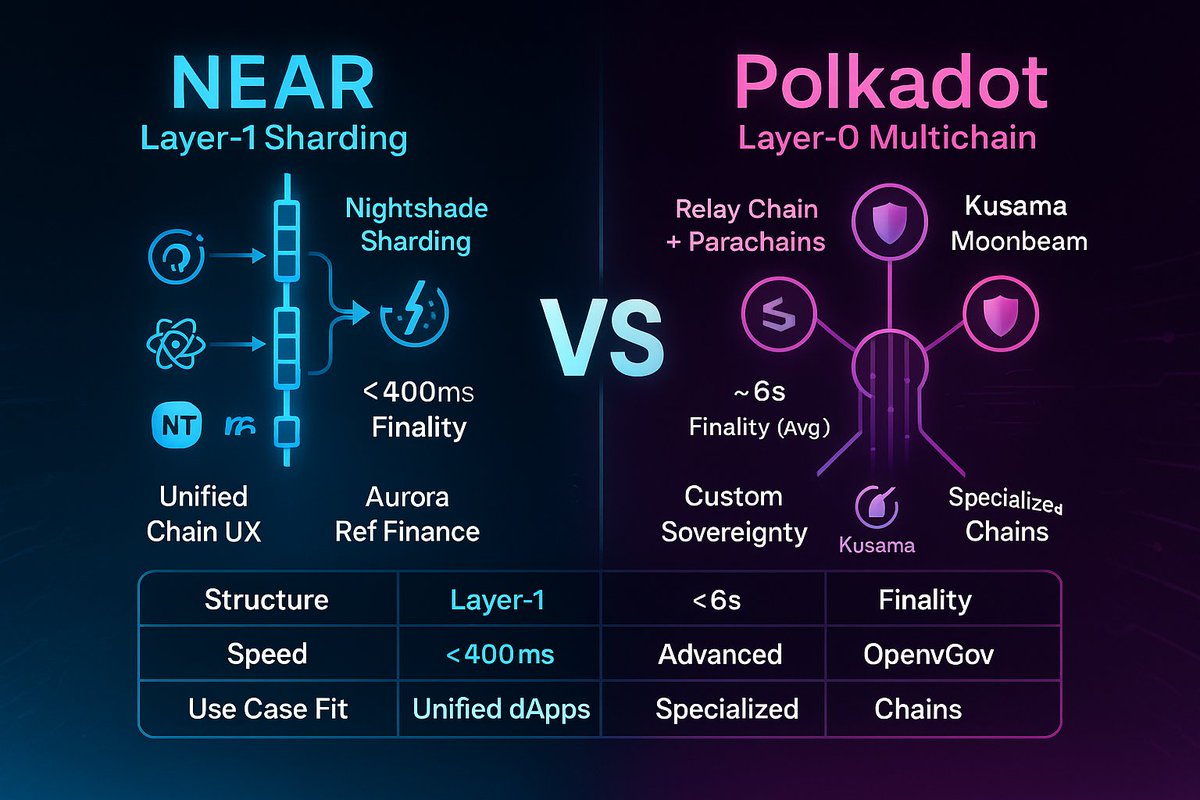[GUEST ACCESS MODE: Data is scrambled or limited to provide examples. Make requests using your API key to unlock full data. Check https://lunarcrush.ai/auth for authentication information.]  Crypto Ninja [@CryptoNinjaPlus](/creator/twitter/CryptoNinjaPlus) on x XXX followers Created: 2025-07-25 13:57:24 UTC NEAR vs Polkadot – Layer-1 Sharding vs Layer-0 Multichain 🤔 Which blockchain wins the scalability race: NEAR’s Layer-1 sharding or Polkadot’s Layer-0 multichain? Let’s break it down! 🌐 NEAR tackles the blockchain trilemma with Nightshade sharding, splitting its network into parallel “shards” to process transactions simultaneously. This delivers sub-second finality (<400ms) and high throughput, making it ideal for DeFi, NFTs, and AI dApps perfect for a seamless user experience. 📊 Polkadot, on the other hand, operates as a Layer-0 protocol, connecting multiple independent blockchains (parachains) via a central Relay Chain. This multichain approach allows specialized chains to scale independently while sharing security, offering flexibility for cross-chain interoperability. 🚀 Why It Matters: NEAR’s sharding optimizes a single chain for speed and cost-efficiency, appealing to developers building unified ecosystems. Polkadot’s multichain design shines for projects needing tailored blockchains, like gaming or enterprise solutions, with robust governance via OpenGov (e.g., Decentralized Voices Cohort 5, launching today!). Both aim for decentralization, but NEAR prioritizes UX with low fees, while Polkadot emphasizes modularity and sovereignty. Which fits Web3’s future best? 🧐 Check the infographic for a side-by-side of NEAR’s shards vs. Polkadot’s parachains, with stats on transaction speed and governance models. What’s your take? Does NEAR’s streamlined sharding outpace Polkadot’s multichain versatility, or does Polkadot’s interconnectivity give it an edge? Share below! 👇 NEAR’s ecosystem (e.g., Aurora, Ref Finance) thrives on simplicity, while Polkadot’s (e.g., Kusama) excels in diversity. As of 2025, both are buzzing NEAR with its move-to-earn trends, Polkadot with its governance push. Which would you build on? Let’s debate! 🖼️ #NEARProtocol #Polkadot #Web3 #Nightshade @KaitoAI @Polkadot @NEARProtocol  XX engagements  **Related Topics** [parallel](/topic/parallel) [blockchain](/topic/blockchain) [ninja](/topic/ninja) [Post Link](https://x.com/CryptoNinjaPlus/status/1948744396029177872)
[GUEST ACCESS MODE: Data is scrambled or limited to provide examples. Make requests using your API key to unlock full data. Check https://lunarcrush.ai/auth for authentication information.]
 Crypto Ninja @CryptoNinjaPlus on x XXX followers
Created: 2025-07-25 13:57:24 UTC
Crypto Ninja @CryptoNinjaPlus on x XXX followers
Created: 2025-07-25 13:57:24 UTC
NEAR vs Polkadot – Layer-1 Sharding vs Layer-0 Multichain
🤔 Which blockchain wins the scalability race: NEAR’s Layer-1 sharding or Polkadot’s Layer-0 multichain? Let’s break it down! 🌐 NEAR tackles the blockchain trilemma with Nightshade sharding, splitting its network into parallel “shards” to process transactions simultaneously. This delivers sub-second finality (<400ms) and high throughput, making it ideal for DeFi, NFTs, and AI dApps perfect for a seamless user experience. 📊 Polkadot, on the other hand, operates as a Layer-0 protocol, connecting multiple independent blockchains (parachains) via a central Relay Chain. This multichain approach allows specialized chains to scale independently while sharing security, offering flexibility for cross-chain interoperability. 🚀
Why It Matters: NEAR’s sharding optimizes a single chain for speed and cost-efficiency, appealing to developers building unified ecosystems. Polkadot’s multichain design shines for projects needing tailored blockchains, like gaming or enterprise solutions, with robust governance via OpenGov (e.g., Decentralized Voices Cohort 5, launching today!). Both aim for decentralization, but NEAR prioritizes UX with low fees, while Polkadot emphasizes modularity and sovereignty. Which fits Web3’s future best? 🧐 Check the infographic for a side-by-side of NEAR’s shards vs. Polkadot’s parachains, with stats on transaction speed and governance models.
What’s your take? Does NEAR’s streamlined sharding outpace Polkadot’s multichain versatility, or does Polkadot’s interconnectivity give it an edge? Share below! 👇 NEAR’s ecosystem (e.g., Aurora, Ref Finance) thrives on simplicity, while Polkadot’s (e.g., Kusama) excels in diversity. As of 2025, both are buzzing NEAR with its move-to-earn trends, Polkadot with its governance push. Which would you build on? Let’s debate! 🖼️ #NEARProtocol #Polkadot #Web3 #Nightshade @KaitoAI @Polkadot @NEARProtocol

XX engagements
Related Topics parallel blockchain ninja